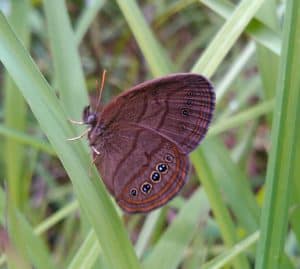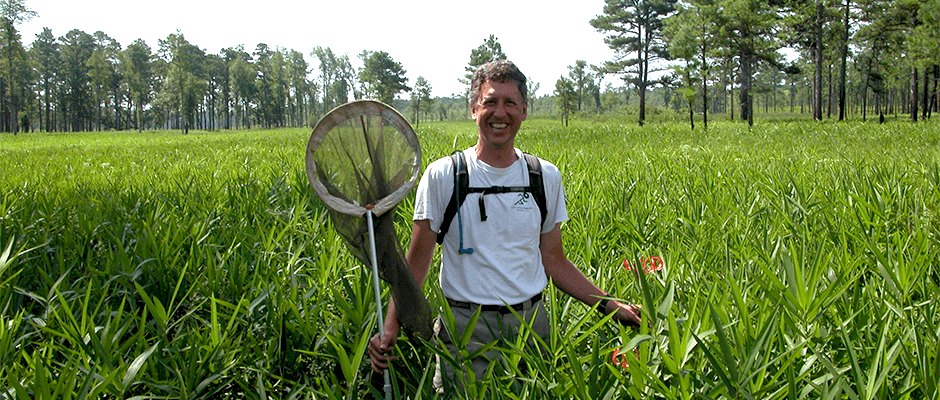Share this article
Recovering with the butterflies
Nick Haddad doesn’t remember it, but while recovering from a traumatic brain injury that resulted in memory loss, he couldn’t stop telling one of his nurses about the rare St. Francis’ satyr (Neonympha mitchellii francisci) — a nearly-extinct butterfly he had been working to recover.
“Nick, how are those rare butterflies?” his nurse asked him a couple of months after he regained his memory.
A professor at the Kellogg Biological Station at Michigan State University, Haddad had been hospitalized in 2014 after he fell while playing basketball and injured his head.
How did the nurse know about the St. Francis’ satyr? Haddad wondered.
“You talked about them every 90 seconds for three days straight,” the nurse told him. It was a testament to just how important the butterfly recovery project he had been working on was to him.
As he recovered from his injury, Haddad gained insights into the butterfly’s recovery, too.

The St Francis’ satyr was nearly extinct before Haddad helped recover populations of the species. ©Jenny M.
His account is part of a collection of Conservation Stories from the Front Lines published this month in PLOS Biology. The collection shows the behind-the-scenes tragedy, comedy and adventures of scientists who work hard to conserve wildlife.
Haddad was using the St. Francis’ satyr as a model organism to understand the effects of landscape change and habitat fragmentation. He got involved in researching the rare butterfly about 15 years ago while working at North Carolina State University, when he received a call from biologists at Fort Bragg asking for his help.
The butterflies are currently only found in southern North Carolina. Historically, their dominant habitat was grassy wetlands along streams surrounded by longleaf pine woodlands maintained by fire, but as people moved into the region and didn’t want fires burning across the landscape, the habitat became shrublands and then forest, which was not adequate habitat for the butterfly — or other wildlife that depended on a landscape regularly disturbed by fire.
Haddad was monitoring seven populations around Fort Bragg’s artillery ranges, and he decided to let nature take its course. The plan backfired, Haddad said. The populations dwindled.
But soon, he gained access to the artillery ranges themselves, where he found, surprisingly, that the areas seemed to be a safe haven for the butterflies.
The butterflies don’t use the areas right where the artillery such as bombs are dropped, Haddad said, but rather the outskirts of the area where the fire spreads.
Haddad and his team also noted the importance of beavers for the species. Beavers create wetlands and then abandon their ponds, which then become grassy meadows, he said. “That’s where the butterflies are.”
While Haddad couldn’t recreate the fire to support the butterfly’s habitat, he could do something about the beavers. He and his colleagues created beaver dams by taking out trees and introducing artificial dams that resembled straightened out inner tubes. They then raised butterflies and introduced them to the area. As years went by, Haddad and his colleagues watched the butterfly populations increase.
“It’s exhilarating,” he said. “Year after year we were walking into a site before restoration, watching populations go down, down, down. It’s hard not to sink spirits down, down, down.”
But as the populations began to recover, Haddad didn’t know he would soon be facing his own recovery from a brain injury. The time off allowed him to think about the butterfly, and other butterflies as well, so he looked for themes in butterfly conservation, he said.
It also allowed him to think about his own condition. He’d need to go through rehabilitation. And if the butterflies were going to recover, they’d need help, too. Letting nature take its course wasn’t always the best option.
“It was a time of reckoning,” he said. “After the accident was a point where I just had time to step back and look at my recovery, and not just my own recovery, but the recovery of butterfly populations.”
For more tales behind the scenes of wildlife conservation, the Western Section of The Wildlife Society has announced the publication of The Wildlife Confessional, an anthology of short stories by wildlife professionals.
Header Image: Nick Haddad holds a butterfly net as part of his rare butterfly research. A traumatic brain injury allowed him to step back and think about the conservation of rare butterflies. Image courtesy of Nick Haddad.








